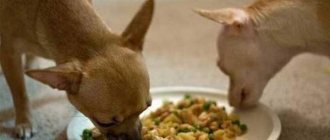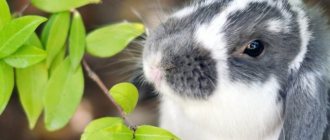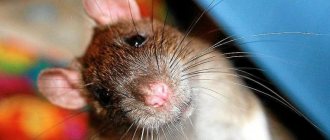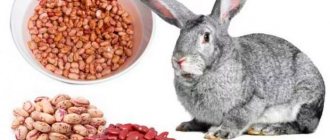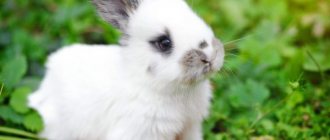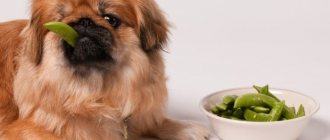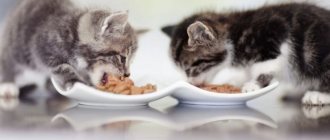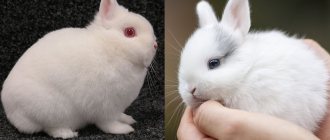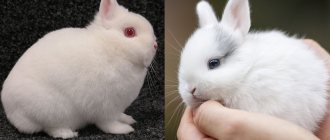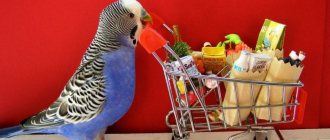Rabbits' intestinal muscles are weak, so they cannot push food through. It is promoted by newly received food, so they eat about 50 times a day. To avoid digestive disorders, you need to properly plan your diet. Therefore, let’s find out how to feed rabbits: what rodents can and cannot eat, and consider an approximate diet for lagomorphs.
Diseases associated with feeding
The main features of the rabbit’s digestive system are:
- Constant growth of teeth (not only incisors, but also molars).
- Inability to vomit (due to the strong sphincter at the entrance to the stomach).
- Focus on processing coarse fiber feed.
- The highest activity of the large intestine (associated with beneficial microflora).
- Formation of feces of two types (night, more nutritious and soft and daytime).
- The phenomenon of coprophagia (eating night feces), the absence or violation of which can cause metabolic disorders and even the death of the pet.
For more information on digestive issues, see the sections: “Bloating in Rabbits” and “Rabbit Teeth.”
The main, most common diseases associated with feeding rabbits are:
- Malocclusion (impaired closure of the teeth of the upper and lower jaw).
- Bloating (indigestion, with increased gas formation).
- Diarrhea and constipation.
- Violation of the formation of feces at night or its formation during the daytime.
- Development of dysbiosis (violation of the ratio of intestinal microflora).
- Metabolic disorders, vitamin deficiency or hypervitaminosis.
- Decreased immunity, with exacerbation of chronic diseases or the manifestation of pathologies associated with carriage (coccidiosis, pasteurellosis and others).
Answers on questions
In the process of raising rabbits, some atypical problems may arise that occur in animals of any age. Let's look at some of the most common ones.
If your rabbit turns away from food
Rabbits' bodies are designed in such a way that they need to constantly chew something. This is important not only for teeth, but also for the entire digestive system. Normally, a healthy animal can have up to 10 meals per day. A rabbit may only turn away from food if there is some illness, usually an infection, viral disease or intestinal problem. In addition, this situation is often observed during teething in young animals, as well as when the rules of keeping are violated (high humidity, non-compliance with temperature conditions).
Even if a rabbit loses its appetite, it must be force-fed.
If he turns over a bowl of food
Rabbits are active animals. They often interact with other individuals and objects in the cage . They most often turn over bowls made of lightweight materials, such as plastic. To avoid this, it is recommended to purchase feeders made of ceramic or galvanized iron.
In addition, such behavior is possible due to poor quality food, as well as behavioral problems, for example, during illness or mating.
Ceramic and iron bowls are more stable and durable than plastic ones.
Often, refusal to eat occurs when there is a hairball in the intestines. A small foreign body leads to digestive problems, and if it grows, serious complications, including death, are possible.
What does the body need for full development and health?
In order to feed rabbits a complete, balanced diet and understand how best to choose it, you need to know what substances necessary for the quality functioning of their body should be contained in the feed. Like any living organism, rabbits need:
- Proteins (are an essential component of any organ or tissue).
The main diet of rabbits is plant foods, but they contain few essential amino acids (which is why they are called incomplete). Essential amino acids cannot be synthesized, so the main source of their supply is food. With insufficient protein intake into the body, various pathologies can develop, for example, this can affect the development of young animals, milk production, the condition of the coat, and so on.
Complete protein feeds are feeds of animal origin (meat and bone meal, fish meal, milk and others). When preparing the diet, it should be selected so that the lack of protein in one type of feed is compensated by another.
- Fats (the main energy source, especially in winter).
They are an integral part of the cell membrane, but the main food for rabbits contains a small amount of them: oats and corn contain up to 6%, wheat and rye contain up to 2% fat, root vegetables - less than 1 percent. Impaired reproduction and deterioration in wool quality are just some of the problems that develop with a lack of fat in the diet. To compensate for the deficiency, oilseeds are used (sunflower seeds, flax seeds and others; they can contain more than 30% fat).
- Carbohydrates (thanks to them, the rabbit’s body produces heat and is converted into fats).
They perform a construction function in the body (participate in the construction of DNA), energy and storage functions (participate in energy production and storage of nutrient reserves). Sucrose, fiber and starch are of primary importance in carbohydrate metabolism.
- The supply of sucrose is provided by fruit crops, melons (pumpkin and watermelons), sugar beets, and carrots.
- Starch is found in tubers and seeds.
- Fiber – digested by intestinal microflora, affects intestinal contractions (peristalsis) and digestive processes. In large quantities (over 25%), it reduces the nutritional value of feed, but its deficiency (less than 10%) will have a negative impact on the activity of the gastrointestinal tract.
- Water (one of the main components of the body - about 65%, and in the blood up to 80%).
A lack of drinking water can lead to dehydration, the development of cannibalism (eating the offspring by rabbits), decreased appetite, weight loss, and even death (if the body loses more than 10% of fluid).
The amount of water consumed by animals depends on feeding (decreases when eating succulent feed), air temperature and humidity, age and physiological state of the body. So, for example, young animals drink on average about 100 ml per kg of weight, adults from 50 to 150 ml per kg, and a pregnant female can consume up to 1.5 liters per day.
Water should be in the drinking bowl all the time, but you need to keep it clean and change it on time (at least 2 times a day). In hot weather it should be cool (but not cold), and in winter it should be slightly warmed up (about 35 degrees).
- Vitamins and minerals (found in organs and cells, affect the course and regulation of many physiological processes).
- Availability of food that requires prolonged chewing and contains silicates to ensure timely abrasion of fast-growing teeth (grass, hay, twig food, fruits, vegetables).
Vitamins
Particular attention should be paid to the content of vitamins B, A, E, D, C and vitamin K in the diet.
- B vitamins stimulate the activity of the nervous system, improve the functioning of the liver (B12) and digestive system. Contained in many feeds and reproduced in the gastrointestinal tract, but when feeding with concentrated feeds, especially in autumn and winter, it is necessary to additionally introduce them into the diet. Contained in fish, oatmeal, meat and bone meal, carrots, bran, green algae.
- A lack of vitamin A will manifest itself in disruption of the nervous system, and dry conjunctiva may also be observed. Contained in green grass, alfalfa hay (destroying during long-term storage), fish oil.
- An insufficient amount of vitamin D causes growth retardation, bone disorders, and the development of rickets. Thanks to sunlight, it is produced by the body. The deficiency is compensated by introducing fish oil or complex vitamin preparations (“trivit”, “tetravit”, “prodevit”) into the rabbits’ diet.
- A lack of vitamin E in feed can lead to disorders in the cardiovascular system, muscular dystrophy and even cause the death of the animal. Contained in sprouted grains of wheat and corn; if necessary, you can use complex vitamins (including injections - intramuscularly).
- Vitamin K regulates blood clotting, is an antidote to rat poisons, and increases platelet levels.
- Ascorbic acid (vitamin C) has a stimulating and anti-inflammatory effect, improves immunity. Contained in greens and vegetables.
It should be noted that pregnant and lactating females, as well as growing young animals, especially need vitamins.
Micro- and macroelements
Phosphorus, calcium and sodium are the most important microelements in the diet, although potassium, manganese, iron, copper, zinc, sulfur and others are also important for the normal functioning of the body and the regulation of metabolism.
Calcium enters the rabbit's body from legumes, hay and straw. There should always be a piece of chalk in the cage, as well as salt as a source of sodium. Phosphorus is found in grain waste, meat and bone and fish meal, as well as green grass and hay. Salt can be added to the food - from half a gram for adults, up to 2 grams for lactating females.
Determining the usefulness of purchased feed
Before purchasing feed, you must carefully study the label attached to it. The packaging must indicate what components the concentrate consists of, as well as the percentage of nutrients. In veterinary medicine, the following nutritional standards have been adopted for adult rabbits:
- raw fiber: more than 18%;
- indigestible elements: more than 12.5%;
- crude protein: 10 to 16%;
- fat: from 1 to 4%;
- calcium: from 0.6 to 1%;
- phosphorus: from 0.4 to 0.8%.
Food should contain vitamins:
- vitamin A: from 6,000 to 10,000 IU per kilogram;
- vitamin D: from 800 to 1200 IU per kilogram;
- vitamin E: from 40 to 70 mg per kilogram;
- trace elements: magnesium 0.3%, zinc 0.5%, potassium 0.6%.
Dr. Dana Krempels recommends the following ratio:
- fiber at least 22%;
- protein no more than 14%;
- fat 1%;
- calcium 1%.
On a note!
Young rabbits require food high in protein and fat.
Finding a feed composition that satisfies all the requirements is quite problematic, so when purchasing, pay attention to the most important factors. For an obese animal, the best choice would be a feed with a high amount of fiber and a reduced amount of fat, for an animal suffering from kidney problems - with a minimal amount of calcium.
What types of food are there?
So, what can you feed rabbits and what types of food are there:
- Combined (compound feed).
- Green (legumes, cereals and wild herbs).
- Succulent (melons and root crops).
- Concentrated (legumes and cereals, oil seeds and bran).
- Coarse (hay, straw, twig feed, corn stalks, hay and grass meal).
- Protein feed (legumes, meal, cake, meat and bone and fish meal, feed yeast, skim milk, and whey).
Compound feed
Compound feed is a combination of different types of grain in one composition, with the addition of micro- and macroelements, as well as vitamins; the mixture is crushed, subjected to special processing and produced in the form of crumbs or granules. It can be of several types:
- Complete feed (used as the only type of food for animals).
- Concentrated feed (used in combination with feeding succulent and roughage).
- Feed additives (used as a supplement to balance the diet in terms of nutrients, vitamins and minerals).
However, it is not recommended to feed rabbits only with compound feed, even if it is complete. This will have a very bad effect on their health (obesity develops, teeth stop grinding down, malocclusion develops, their intestines lose the ability to digest and assimilate large volumes of roughage and green feed, the immune system weakens and various pathologies begin to appear).
Green food
Herbs are exactly what you need to feed your rabbits. They are a source of many useful substances (proteins, vitamins, carbohydrates and minerals), in addition, due to the long process of eating (about 7 - 8 minutes) and the content of silicates, they contribute to the natural process of tooth abrasion, preventing the development of pathology.
Young herbs are best absorbed, this is due to the fact that over time the amount of fiber in the grass increases and nutritional value decreases (vitamin and mineral composition worsens), and, accordingly, its digestion worsens. Therefore, it is best to give animals young plants, mowed before the coarsening stage begins. In the village, this is one of the most accessible feeds in the warm season.
Both specially cultivated grasses (legumes and cereals) and wild ones are used as green feed. From the legume family, both separately grown (peas, clover, vetch and alfalfa) and mixtures with cereals (vegetable-oat and a mixture of oats and peas) are used. One of the best cereal options is oats. It is quite high in calories and can be sown twice a season. Thanks to the use of such nutritious green feeds, it is possible to almost halve the content of expensive concentrated feeds in the diet; in addition, they are more useful and have a beneficial effect on the condition of animals.
Wild herbs are the most affordable food for rabbits at home. Although this is a less nutritious type of feed, it does not require any material costs. The conditions for their procurement are the same as for cultivated plants.
In addition, we should not forget about poisonous herbs; they pose the greatest danger to young animals, since adult rabbits may not eat them, although the danger still exists and it is better not to feed the most dangerous species at all.
What you should not feed rabbits (the most dangerous): delphinium or larkspur, sultana or dog parsley, chelidonium or celandine, spotted hemlock, hemlock or poisonous wech.
There are also a number of plants whose toxic properties are lost when dried, that is, they can be harvested for hay: this is the same dog parsley, ranunculus or buttercup, anemone or anemone, solanum or nightshade. For those who are not very familiar with these plants, it is advisable to find photographs of them and study them in more detail in order to avoid mass deaths of their pets when they are included in the diet.
Juicy food
Root crops and melons, which are classified as succulent food, make the diet more nutritious, stimulate the reproduction of pets and milk production in nursing rabbits. They are tasty and easily digestible food for rabbits; they improve appetite, so they are also used for rapid growth and weight gain in young animals during fattening.
Under no circumstances should you give frozen succulent food ; if it is frozen, it must be thawed, cleaned of missing parts and cooked, and only then given to your pets.
Ushastiki can be fed potatoes. But this vegetable has some features. When exposed to light, it can produce toxic substances, so you should not give animals green potatoes and vegetables that have been stored for a long time in an undarkened room. You should also not give potato tops.
You can feed raw potatoes, but not earlier than four months, little by little, watching the stool. The vegetable must be thoroughly washed and cut into pieces. In the general diet it should be no more than 10 parts.
The situation is simpler with boiled potatoes. It can be given either cut or crushed, introduced into mash with mixed feed, concentrated feed and other vegetables. But its amount should be up to 10% of the total amount of feed.
Many rabbit breeders use potato peelings for feeding. They can be given only in small quantities so as not to cause digestive upset in the pet. In this case, the skins need to be washed well, dried, poured boiling water and added to the mash with other feed.
You can feed your pets pumpkin and zucchini, fodder watermelons, turnips, rutabaga, kuusika (the result of crossing turnips, fodder cabbage and rutabaga). Rabbits love the latter crop very much and eat it with great pleasure.
When feeding pumpkin, it can be given raw, cut into pieces. But if animals are reluctant to eat it, it is better to boil the pumpkin, crush it and give it in this form as part of mash. It is better to give zucchini a little unripe, so they are healthier (in composition) and are better absorbed.
Jerusalem artichoke and carrots are the most popular with rabbits. In addition, carrot tops can be given to animals without mixing with other feed. While other types of root crop tops should be given gradually, very little by little, eventually reaching 40 grams for young and 50 grams for adults. And at the slightest sign of disorder it is better to exclude it.
Cabbage is also one of the favorite dishes of eared ears, but its quantity should be strictly limited, due to the fact that in large quantities it can cause bloating and even lead to death. A very good variety to introduce into the diet is kohlrabi. It is distinguished by a high content of fiber in its composition, as well as ascorbic acid and sugar, so it must be given carefully and gradually. You can also make high-quality and healthy silage from kohlrabi.
You can and should feed your pets sugar beets. But at the same time, you need to know that this must be done very carefully and gradually (otherwise it can even lead to the death of the animal), starting from 1-1.5 months and giving up to 25 grams per feeding, but no more than twice a day. The dose is doubled monthly; it is not recommended to give adult animals more than 300 grams per day (at least two doses).
Can also be used for feeding and fodder use. Fodder beets can be fed in the same way as sugar beets, although the latter is more beneficial. But feeding the table variety of this root vegetable is strictly prohibited (only for yourself, when preparing borscht or in other dishes).
Concentrated feed
Due to the high concentration of nutrients (carbohydrates, protein, fats and fiber), cereal grains, legumes and oilseeds, as well as a by-product of the flour milling industry, such as bran, are concentrated types of feed. Let's try to figure out which grain is best to feed your pets. In fact, it depends on the purpose of breeding (fattening, for skins, etc.) and the physiological state of the animals (sometimes nutritional correction may be required).
When choosing what grain to feed, you need to know that the preferred ones (in order of quality deterioration) for rabbits are:
- Oats (in addition to the above nutrients, due to the presence of a large amount of pantothenic acid, has a beneficial effect - it stimulates metabolic processes, has an anti-inflammatory effect, stimulates peristalsis, up to 30% of the diet content can be introduced).
- Corn (in addition to being high in carbohydrates, it contains a lot of fat and vitamin E, it is an energy source for animals, it is better to give it crushed, along with the kernels, but not to store it, due to possible rancidity).
- Wheat (less nutritious than corn, but richer in B vitamins, also contains vitamin E and up to 15% proteins; feed wheat, like corn, can fill up to ¼ of the total diet).
- Barley grain (belongs to forage crops due to its lower nutritional value than the previous two, can only be given in crushed form).
- Bran (rich in proteins, phosphorus and vitamins, can have a laxative effect).
Roughage
This group of feeds is exactly what you can feed rabbits in winter, although some types of roughage can be added in the warm season (to correct the diet). Rough feeds include:
- Hay (contains minerals and vitamins, up to 5% digestible protein, thanks to prolonged chewing it prevents the development of dental pathology; alfalfa hay is considered the most nutritious).
- Branch food (rich in carotene, vitamin E and ascorbic acid, such an important mineral for rabbits as cobalt, as well as manganese, harvested before the buds open, it is better to store it in the form of brooms).
- Herbal flour (usually made industrially, after thorough drying, can be from any herbs; in winter, at home, you can prepare it yourself, using hay leaves, preferably alfalfa).
- Straw (oat straw is considered the most nutritious, but it can have a laxative effect, but barley straw can strengthen, it is rarely used for feeding, most often in winter, if there is no hay and there is not enough fiber in the diet, and also for building nests).
Vegetable protein food
This group of feeds includes legumes (soybeans and peas), as well as processed products (meal and cake) and feed yeast (the result of biochemical processes for processing corn cobs and straw).
Soybeans and peas (contain up to 40% protein, are well digestible, are given only in crushed form, as part of mash, and can make up up to 10% of the diet).
Meal and cake (they contain up to 5% fat and up to 50% protein, are fed as part of mash or in mixed feed).
Feeder yeast (fats, carbohydrates and almost half of the composition is protein) is also used as a nutritious food additive.
Protein feed of animal origin
As animal proteins, to improve the diet and to quickly gain weight, rabbits use meat and bone and blood meal (from gram to eight grams for young animals and up to 10 grams per adult), as well as skim milk and whey (up to 50 grams for young animals and lactating females).
In addition, the following mineral supplements can be used: chalk, eggshells (fried), table salt (up to 0.5% of the diet composition).
Average daily ration
When calculating the feed dose in g per day, domestic rabbit breeding takes as a basis the maximum diet of adult rabbits:
| Food variety | Female rabbits and rabbits in the resting stage | Pregnant rabbits | Lactating rabbits |
| green vegetation | 800 | 900 | 1500 |
| Silage | 300 | 200 | 400 |
| Roots | 250 | 200 | 350 |
| Hay | 200 | 175 | 300 |
| Branches | 100 | 100 | 150 |
| Cereals | 50 | 100 | 140 |
| Beans | 40 | 60 | 100 |
| Oilseeds | 10 | 15 | 20 |
| Bran | 50 | 60 | 100 |
| Cake | 10 | 25 | 33 |
| Schrot | 20 | 30 | 60 |
| Cabbage | 400 | 400 | 600 |
| Vegetables | 200 | 250 | 300 |
| Milk products | – | 50 | 110 |
| Bone meal | 5 | 8 | 12 |
| Feed with minerals | 2 | 3 | 4 |
In winter, when rabbits do not produce offspring, their feeding is done moderately. The standards are given for an average rabbit weight of 4-4.5 kg. The share of feed for domestic decorative rabbits is calculated based on its weight.
Feeding principles
So, how to feed rabbits correctly:
- Since they eat very often (almost all the time, 40 - 50 times a day), food should be constantly available, especially in the evening and morning hours.
- The same situation (should happen all the time) with water, which must be clean. To a greater extent, it is required for dry feeding (hay and compound feed), as well as for young animals, pregnant and lactating rabbits.
- Any new type of food is introduced only gradually, over at least a week, the same rule applies to transition periods (autumn and spring).
- If different types of feed are fed simultaneously, grain feed is given first, and only then juicy and rough (in the cold season) or green (in summer).
- For eared animals, the feeding regime is very important, so it is advisable to develop a certain routine and in no case violate it (this way the food is better absorbed, otherwise indigestion may occur).
- Feed cabbage and tops of root crops (except carrots) are given along with hay, grass or tree branches that have fastening properties (for example, oak).
- It is better to give the grass slightly dried.
- It is better to give grains and cake crushed.
- Food should be placed only in the feeder and under no circumstances on the floor (it will become dirty, spoil, and can lead to the development and transmission of diseases).
- With the exception of hay and grass, uneaten remains of feed should be removed.
- You can only use high-quality food; if there is any doubt about the latter, it is better not to give it.
Frequency of feeding and watering
Each person determines how many times a day to feed rabbits for himself, depending on his capabilities. It is recommended to feed young animals, pregnant and lactating rabbits at least three times a day; for adults, two or three times feeding is most often used.
How many times a day should you drink? Usually this is also two or three times, although the best option is to use automatic waterers so that the animals have constant access to water.
Feed quantity
The required amount of feed is determined by the animal’s eating and condition; if the feeder quickly turns out to be empty, it means there was not enough feed. You can roughly calculate how much feed a rabbit needs per day using the recommended ratio: in the cold season, for an adult, about 45% of roughage, up to 40% of grain feed and up to 30% of root crops are needed; in the summer, the proportion is transformed into the amount of succulent feed and grass up to 55% and up to 45% concentrates.
What not to feed
Let's figure out what and how not to feed rabbits at home. Remember that you cannot:
- Give water both before and immediately after grass feeding.
- Give wet grass.
- Spoiled or moldy feed.
- Drastically change your diet or introduce new foods quickly and in large quantities.
- Some herbs (delphinium, znoha, chelidonium or celandine, spotted hemlock, hemlock, buttercups, anemone, nightshade, field or wild radish, horsetail, potato stems).
- Branches of some plants (elderberry, all varieties of wolfberry, all species of the euonymus family, bird cherry).
- Millet, rice, millet, rye - both porridge and grain.
- All types of sweets, homemade and store-bought baked goods.
- Anything that is spicy, salty, smoked, fatty or contains dyes, flavors or preservatives.
- I eat food from the table or its leftovers, with rare exceptions (can be found above - potatoes, peelings, and so on, but only in small quantities, specially prepared and as part of mash).
- Citrus and exotic fruits.
You should always remember that rabbits are herbivores, while humans are omnivores.
What not to feed
Rabbits are herbivores, characterized by their gluttony and omnivorous nature. At the same time, they are extremely sensitive to the quality of food, as well as its content. From the large number of possible products for feeding these animals, the following components that pose a health hazard should be excluded:
- red beets;
- rotten and moldy grass, hay and straw;
- poisonous plants and trees (hemlock, belladonna, lily of the valley, dope, spurge, apricot, buckthorn, wild rosemary, bird cherry and others);
- poor quality silage;
- sweets and baked goods;
- frozen or rotten root vegetables.
Hay made from marsh grasses is especially dangerous for rabbits. Regular feeding of such food can lead not only to digestive problems, but also death due to poisoning. Vegetables and fruits should be given in limited quantities.
Features of feeding by physiological groups
All rabbits can be divided into the following groups:
- Young animals
- Adults in a calm state
- Mating preparation group
- Pregnant rabbits
- Nursing (lactating)
Feeding the young
From the moment of birth until three weeks of age, baby rabbits feed on mother’s milk (if there are problems with it or not enough, it is necessary to feed it, preferably with goat’s milk or infant formula). From three weeks, babies begin to be interested in the adult foods that their mother eats. Ideally, by the time they are weaned (usually at 2, or preferably 3 months), they are already accustomed to the gentle and nutritious feed that lactating rabbits receive and are ready to feed on their own.
What to do if a female rabbit’s lactation ends earlier or is weaned at 30 days, what to feed month-old rabbits? Such babies can be fed with high-quality hay, young grass, a little feed, carrots (first you can grate them on a coarse grater), you can give a mixture of boiled potatoes and bran, chopped fodder beets.
A good food for young rabbits is young grass, but if it is not available, bone meal is introduced into the diet; age in months corresponds to the number of grams per day: one month - 1, two months - 2, and so on up to four.
Adults at rest
The most undemanding group in terms of nutritional diet. In cold weather, it is enough for them to give plenty of legume hay, but if the roughage is not of very high quality, it is necessary to add up to 50 grams of grain. In the summer, you can limit yourself to the free distribution (as much as you eat) of good herbs. In weight equivalent it may look like this - about 200 grams of hay, 40-50 grams of grain or up to 1 kg of grass; in both periods it is advisable to add up to 1 gram of chalk and salt.
Mating preparation group
The quality and quantity of offspring depends on the quality of nutrition of animals in this group (it affects the sperm and activity of the rabbit, as well as the female’s ability to fertilize).
For males, you need a composition of high-quality grasses or hay and the mandatory presence (up to 150 grams) of grain or mixed feed. A balance of vitamins (A, B, E) and minerals (calcium and phosphorus) is required.
Before mating, both males and females should be in the best condition (neither thin nor fat). Therefore, appropriate adjustments are made in the direction of decreasing or increasing the nutritional value of feeding and the balance of vitamin and mineral composition (fish oil, fish or meat and bone meal, and others).
Feeding babies
A female in normal condition can be fed only high-quality hay or grass from the moment of mating until fertilization is confirmed (about two weeks), without adding other foods. Next, up to 50 g of concentrates are added, as well as about 300 g of root crops and silage.
From the beginning of the second half of pregnancy, up to 1.5 grams of fish oil and about 3 grams of meat and bone meal are added. 10 days or a week before birth, exclude silage from the diet, reduce hay and green feed and increase the content of concentrated feed. Pregnant rabbits should not be allowed to become obese; this can cause the development of various pathologies (stillborns, low milk supply) and even lead to death.
Nursing rabbits
The most stressful time for the female body is feeding the young; it needs to produce up to 300 grams of highly nutritious milk. Therefore, feeding must be appropriate, otherwise it will definitely affect the health of the mother and the rabbits.
The diet must be varied and contain the required amount of vitamins and minerals. Grass and high-quality hay, grains and succulent feed have a beneficial effect on milk production.
Wheat bran with boiled potatoes is introduced into the diet, hay should be of high quality, soft and small, concentrated feed should only be crushed, and vegetables should be chopped. In cold weather, the amount of succulent feed can reach up to a kilogram.
If a baby rabbit weighs about 300 grams at the age of three weeks, and about 600 grams per month, then the feeding is correct.
Nutrition standards
The volume and variety of food differs depending on the condition of the animal, the time of year and the age of the individual. There are developed standards for feeding rabbits at different periods. These indicators are calculated for medium and large breeds weighing up to 5 kg of live weight.
| Green feed | Juicy feed | Roughage | Concentrates | |
| Female and male in physiological rest | up to 500 g | 100 g in summer, 200 g in winter | 100 g in summer, up to 150 g in winter | 50 g in summer, 60 g in winter |
| Before mating female and male | up to 600 g | 150 g in summer, 220 g in winter | 150 g in summer, up to 200 g in winter | 80 g in summer, 100 g in winter |
| Pregnant female | up to 700 g | 200 g in summer, 250 g in winter | 150 g in summer up to, 250 g in winter | 90 g in summer, 120 g in winter |
| Rabbits (from 1 month) | 300 g | 100 g in summer, 150 g in winter | 40 g in summer, up to 60 g in winter | 30 g in summer, 40 g in winter |
The feeding system for baby rabbits differs from the rules for adults. At the age of up to 1 year, feeding occurs naturally or with the help of goat's milk if the female has insufficient lactation.
Features of fattening
When breeding for meat, the necessary adjustments are made 30 days before slaughter. This time is divided into three phases, 10 days each:
- Preparatory.
- Home.
- Final.
Preparatory phase
In order for pets to gain weight, the volume of roughage is reduced and the amount of concentrates is increased. Since rabbits actively feed in the evening and morning (in poor lighting), the windows in the room need to be darkened.
What is the best way to feed rabbits at this time: good hay, forbs and grasses of the legume family, corn and barley grain, wheat bran, cake, cabbage, carrots.
Main phase
Feeding is aimed at fat deposition. They give corn and peas, boiled potatoes and bran (the rest of the vegetables are removed, instead of bran you can give compound feed), they give a little hay, and include a variety of greens in the diet.
Final phase
The main task is to support appetite and continue weight gain. Taste stimulants are introduced: dill herb, basil, caraway and others. Hay is removed (can be given only in case of indigestion) and succulent food.
They give potatoes with mixed feed or bran, cereal-legume mixtures of herbs, summer twig food, grains, dill or caraway seeds. You can add rutabaga or soy.
When animals become lethargic, inactive and begin to lose appetite, fattening is over.
It is important to know that industrial breeding without using a sufficient amount (up to 60%) of concentrates is very problematic. And if there are enough of them, fattening can be completed once the animals reach three months of age.
Self-production of feed
A prerequisite for this is the presence of a grain crusher. For complete mixing, all components must be ground to a homogeneous mass. To mix small volumes, you can use an electric drill with an attachment; for continuous feed production, it is easier to purchase a concrete mixer.
Full ration food recipe
- In a grain crusher, grain is ground into flour. 20% barley, 10% wheat, 10% corn, 5.5% soybeans are poured into the container.
- Add 40% of the volume of the container of chopped hay to the resulting mixture.
- Next, the sunflower cake is finely crushed and added in the amount of 10% of the volume.
- The total mass is filled with 2% feed yeast, 0.3% salt, 2.2% meat and bone meal.
The mixture is thoroughly mixed.
Features of feeding at home
How to properly feed rabbits at home - the principles remain the same, with the difference that if there is no food of some kind, they are replaced with what is available.
Nutrition for rabbits at home depends on what result you want to get. If you need quick results, you will have to spend money on expensive concentrated feed. And if this is a subsidiary farm, then it is better to calculate in advance what of the necessary feed grows on the site, and what needs to be prepared additionally.
If you have your own garden and a lot of fruit, you can feed your rabbit apples, but this does not mean that you can give them only. Apples should be introduced into the diet gradually and in small quantities so as not to cause disturbances in the digestive system. It is better to use them as a treat.
In winter, you can use branches of coniferous trees, again gradually (from 10 grams to 150), every 20 days you need to take a week break.
If the animals are not decorative (otherwise they will get fat), you can feed them bread, but you must follow the following rules:
- Do not give it fresh.
- Black bread and any rye products are contraindicated (they cause increased gas formation).
- No feeding with baked goods.
- It should be given little by little and in a dried form.
You can prepare food for rabbits with your own hands, for example, silage: carrot stems, legumes and kale (20% each), carrots themselves (up to 20%) and mashed potatoes (20%). Everything is cut into small (1 - 2 cm) pieces, placed in a barrel or hole covered with film, rammed and covered with the same film, sawdust and soil can be added on top. After 45 – 60 days the silage is ready.
If you carefully understand, study the basic principles of what can and cannot be given, then the question of how to feed rabbits at home will disappear by itself.
Use of veterinary drugs
Both for those who are learning for the first time what to feed a domestic rabbit, and for experienced rabbit breeders, it is useful to know that:
- Timely prevention of coccidiosis helps prevent the development of inflammation and destruction of the intestinal mucosa, which helps to avoid growth retardation in young animals.
- The use of the drug “vetom” improves the functioning of the digestive system and improves immunity.
- To improve the ratio of calcium and phosphorus, stimulate metabolic processes and improve liver function, “catozal” is used. It can be used either in injection form (which is more effective) or given orally (with water or food).
- To increase weight gain, significantly improve the quality of skin and coat, for show animals, the use of the drug “nucleopeptide” is very effective.
A high-quality and balanced diet is the basis for the health of the animal, as well as the peace and well-being of its owner.
Reviews
Nikolay, 37 years old
We have a large farm, so we specially go to the feed mill to buy feed. To save money, we buy concentrates, which we add to the main diet. We directly pour the granules into the feeders, and we dilute the loose feed and give it out in mash. After switching to specialized feed, our weight gain increased and the quality of the skins improved.
Elena, 29 years old
I have a small decorative rabbit, it eats very little, I buy a full ration of food for it at the pet store. Very convenient: the bag for the animal contains a specially selected composition of vitamins, fiber, proteins, protein, and microelements. There is no need to think about what to feed your pet - just pour granules into a cup, and all problems are solved. After eating, the rabbit is always cheerful and energetic, the fur is smooth and shiny.
In modern rabbit farming, the use of compound feed is a prerequisite for obtaining stable weight gain, high-quality wool and healthy offspring.
